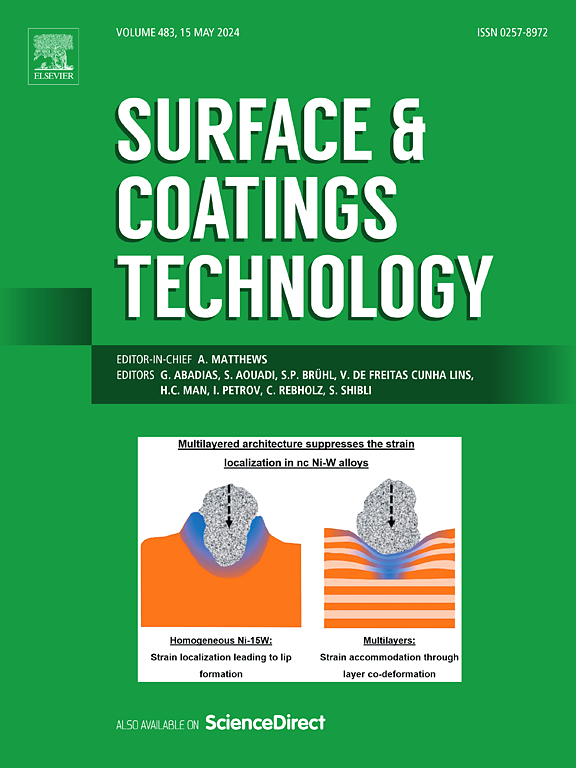Effect of bath temperature on the microstructure and electrochemical properties of (Si, Ti) micro-alloyed Zn-6Al-3Mg hot-dip coatings
IF 5.3
2区 材料科学
Q1 MATERIALS SCIENCE, COATINGS & FILMS
引用次数: 0
Abstract
The bath temperature exerts a significant influence on the microstructure and corrosion resistance of Zn-Al-Mg coatings, yet systematic investigations in this field remain limited. In this work, Zn-6Al-3 Mg-0.1Si-0.05Ti coatings were prepared at different bath temperatures to investigate the influence of bath temperature on their microstructure and electrochemical properties. The results indicate that higher bath temperatures promote the nucleation and growth of the Fe![]() Al alloy layer, leading to a reduction in the Al content within the coating. On one hand, this results in the disappearance of Al-rich dendrites within the coating, thereby altering the cathode of the electrochemical corrosion and reducing the difficulty of charge transfer. On the other hand, it modifies the morphology of the ternary eutectic and the proportions of its constituents, consequently influencing the protective properties of the corrosion products. When the bath temperature is maintained at 450 °C, the coating demonstrates optimal corrosion resistance. The high proportion of ternary eutectic, which contain abundant Al-rich and MgZn2, is probably the key factor of the improved corrosion resistance.
Al alloy layer, leading to a reduction in the Al content within the coating. On one hand, this results in the disappearance of Al-rich dendrites within the coating, thereby altering the cathode of the electrochemical corrosion and reducing the difficulty of charge transfer. On the other hand, it modifies the morphology of the ternary eutectic and the proportions of its constituents, consequently influencing the protective properties of the corrosion products. When the bath temperature is maintained at 450 °C, the coating demonstrates optimal corrosion resistance. The high proportion of ternary eutectic, which contain abundant Al-rich and MgZn2, is probably the key factor of the improved corrosion resistance.
镀液温度对(Si, Ti)微合金Zn-6Al-3Mg热浸涂层显微组织和电化学性能的影响
镀液温度对Zn-Al-Mg涂层的组织和耐蚀性有显著影响,但在这方面的系统研究还很有限。本文在不同的镀液温度下制备了zn - 6al - 3mg -0.1 si -0.05 ti涂层,研究了镀液温度对其微观结构和电化学性能的影响。结果表明,较高的熔浴温度促进了FeAl合金层的形核和生长,导致涂层内Al含量降低。一方面,这导致涂层内富al枝晶消失,从而改变了电化学腐蚀的阴极,降低了电荷转移的难度。另一方面,它改变了三元共晶的形态及其组分的比例,从而影响了腐蚀产物的防护性能。当镀液温度保持在450℃时,涂层表现出最佳的耐腐蚀性。高比例的三元共晶,含有丰富的富al和MgZn2,可能是提高耐蚀性的关键因素。
本文章由计算机程序翻译,如有差异,请以英文原文为准。
求助全文
约1分钟内获得全文
求助全文
来源期刊

Surface & Coatings Technology
工程技术-材料科学:膜
CiteScore
10.00
自引率
11.10%
发文量
921
审稿时长
19 days
期刊介绍:
Surface and Coatings Technology is an international archival journal publishing scientific papers on significant developments in surface and interface engineering to modify and improve the surface properties of materials for protection in demanding contact conditions or aggressive environments, or for enhanced functional performance. Contributions range from original scientific articles concerned with fundamental and applied aspects of research or direct applications of metallic, inorganic, organic and composite coatings, to invited reviews of current technology in specific areas. Papers submitted to this journal are expected to be in line with the following aspects in processes, and properties/performance:
A. Processes: Physical and chemical vapour deposition techniques, thermal and plasma spraying, surface modification by directed energy techniques such as ion, electron and laser beams, thermo-chemical treatment, wet chemical and electrochemical processes such as plating, sol-gel coating, anodization, plasma electrolytic oxidation, etc., but excluding painting.
B. Properties/performance: friction performance, wear resistance (e.g., abrasion, erosion, fretting, etc), corrosion and oxidation resistance, thermal protection, diffusion resistance, hydrophilicity/hydrophobicity, and properties relevant to smart materials behaviour and enhanced multifunctional performance for environmental, energy and medical applications, but excluding device aspects.
 求助内容:
求助内容: 应助结果提醒方式:
应助结果提醒方式:


